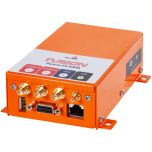PowerFLARM® Portable

General Description
PowerFLARM® Portable is for aircraft where a behind the panel installation is not possible, the PowerFLARM® Portable is available for flexible fitting. This device incorporates a display as well as a control knob and can easily be placed e.g. on the glareshield.
Note that Portable is available in an EUROPE and AMERICAS version. The EUROPE version runs in Europe, Africa and New Zealand. The AMERICAS version runs in North and South America, Australia and Israel. The hardware has built–in hardware frequency filters to the frequencies applicable in these regions. ADS–R and UAT are not supported.
What is FLARM?
FLARM is a traffic awareness and collision avoidance technology for General Aviation, light aircraft, and UAVs. With FLARM installed, you are alerted of both traffic and imminent collisions with other aircraft, so you can take action before it is too late.
Over 35,000 manned aircraft and many UAVs are already equipped with FLARM and the number is rapidly increasing. FLARM systems are available from several manufacturers for powered airplanes, helicopters, gliders, and UAVs.
Features
• FLARM functionality – sending out your position and vector and receiving vectors from gliders in range (about 4 miles)• ADS–B Traffic Reception – ADS–B traffic position and relative altitude are displayed on the PowerFLARM display.
• Mode S Transponders – Nearby Mode S transponders are displayed on the PowerFLARM display. Since direction is not known, the traffic is displayed as a ring around the glider.
• Mode C Transponders – Nearby Mode C transponders are displayed on the PowerFLARM display. Since direction is not known, the traffic is displayed as a ring around the glider.
• 2nd FLARM Antenna Port Enabled (2nd antenna not included)
• Audio Output Enable – The built–in audio output port for sending FLARM alarms (beeps only) to an aviation headset is enabled by default.
• GPS Flight Recorder – Accepted by OLC, no IGC Approval or task declarations
What's in the Box?
• PowerFLARM Portable unit• PFLARM–Ant–ADS–B–Rod-RP – ADS-B antenna
• PFLARM–Ant–FLARM–Rod–RP – FLARM Antenna
See & Be Seen by Everyone
Introduced over a decade ago, the original Classic FLARM devices have saved the lives of many glider pilots. Thanks to the success of FLARM, and because of more crowded airspace, FLARM has also been embraced by other aviation domains. Today, many powered airplanes, helicopters, and even low flying jet aircraft carry FLARM. There is no other technology as widely used in the lower airspace below FL100, outside large airports, than FLARM. Together with a general increase in high speed aircraft at lower altitudes, this changes the technical requirements for collision avoidance equipment to detect fast approaching aircraft in time. PowerFLARM was developed to specifically address these challenges.
PowerFLARM® makes aircraft that are hidden from old Classic FLARM visible. With a significantly increased range, radio performance improvements in all directions, and optional ADS–B and transponder data integration, PowerFLARM protects you from aircraft otherwise not visible in time.
Transponder and ADS–B Receiver
While many aircraft are already FLARM–equipped, there are still some that are not. With the optional transponder and ADS–B 1090ES receiver, available in select PowerFLARM® devices, you are protected from those aircraft as well. The additional receiver listens for intruders transmitting Mode–C, Mode–S, and ADS–B messages on 1090 MHz, and includes those aircraft in the smart trajectory prediction and collision warning algorithms. Since aircraft without FLARM cannot see you, it is all the more important that you can see them early to keep a safe distance.
Display
• New generation sunlight-readable Matrix TFT display• Resolution 132 x 176 pixels
• 2″ diagonal screen
Power
• 12 V DC nominal (8–23V DC ) external• 6 removable rechargeable AA batteries (exceptionally also non–rechargeable
• Up to 7.5h battery runtime, (depending upon traffic, temperature and type of battery)
Communication
• Internal RS232 NMEA0183 or GARMIN®–TIS• Data output for Moving-Map units and external displays (only one user at a time!)
• internal 3V power supply for remote displays
Antennas
• Two 868–930MHz FLARMantennas (red marking): FLARM A (send/receive), FLARM B (receive only)• ADS–B antenna (blue marking; receive only; non–“Pure” devices)
• Integrated GPS antenna under top of housing
• Optional: External GPS antenna (MCX socket)













